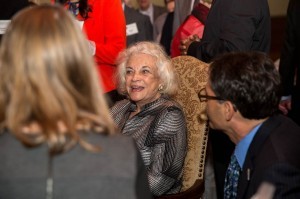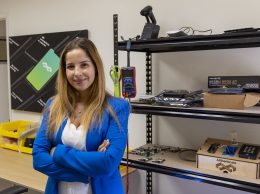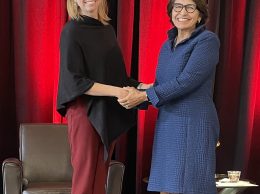O’Connor recalls barriers women attorneys faced
IN THIS ARTICLE
- Features Topic
- Tom Bronzini Author
By Tom Bronzini Friday, October 31st, 2014
Retired Supreme Court Justice Sandra Day O’Connor, the first woman to serve on the nation’s highest court, recalled during an appearance at Cal State Channel Islands that in order to land her first job as an attorney after graduating high in her class at Stanford Law School, she offered to work for free and share a desk at the office.
The former associate justice , who stepped down in 2006, charmed an audience of 600 Thursday evening with often amusing stories of how she got her start after growing up as a cowgirl on a Southwest cattle ranch, and how she overcame the formidable barriers women faced in the legal profession. She spoke at a program hosted by the university’s history and political science programs.
, who stepped down in 2006, charmed an audience of 600 Thursday evening with often amusing stories of how she got her start after growing up as a cowgirl on a Southwest cattle ranch, and how she overcame the formidable barriers women faced in the legal profession. She spoke at a program hosted by the university’s history and political science programs.
Justice O’Connor was interviewed onstage by attorney Kathleen Smalley, one of her first law clerks on the high court who is now with the national law firm Boies, Schiller & Flexner LLP.
O’Connor recalled that after graduating in a Stanford law class that included William Rehnquist, who became the 16th U.S. Supreme Court chief justice, she interviewed at law firms and was asked how well she could type. “They just didn’t have many women in the legal profession in those days and the firms really weren’t looking for us,” she said.
She was hired in 1952 as a deputy attorney at the San Mateo County Attorney’s Office at very low pay after she offered to work for free and share a desk.
After her husband, attorney John O’Connor, was drafted into the Army, she went with him to Germany and worked as a lawyer for the Army’s Quartermaster Market Center in Frankfurt. Upon their return to the States in 1958, she found that nothing had changed; law firms were still not hiring women.
O’Connor set up her own practice and found that it was hard to get business. “But it all worked out,” she said to laughter from the audience. She later served as assistant attorney general of Arizona from 1965 to 1969.
At that point in her career, she entered the political arena and eventually became majority leader of the Arizona State Senate, the first woman in a leadership position in a state legislature.
When Smalley asked the former justice why she decided to enter politics, O’Connor quipped, “Well it was easier than getting a job.”
In the Legislature, O’Connor was a leading advocate of merit selection of judges, a scheme approved by voters. “…We still have it and it’s been a great thing, it really has,” O’Connor said. “I wish every state would adopt that.”
O’Connor became a trial judge in Arizona, and under that merits election system, she rose to the Arizona Court of Appeals.
O’Connor said it was a big surprise when Ronald Reagan asked her to be his nominee to the U.S. Supreme Court. She said she was thrilled and happy to take on the challenge. “If I goofed up, it was going to set things back pretty badly,” she said. “I worked hard to try not to leave a bad impression and it was a wonderful experience.”
She won unanimous support from the Senate and served on the high court from 1981 to 2006. She won votes from diverse quarters, from Sen. Barry Goldwater on the right to Sen. Ted Kennedy on the left.
Smalley took note of the current political rift in Washington and asked the former justice if there is something wrong with the way we are going about nominating and trying to confirm justices of the Supreme Court.
“Oh I don’t think so,” O’Connor said, “because I think members of the Senate do have the power to vote no on a nominee if they think the person isn’t qualified. I think that’s one of the inherent benefits of being a senator. So you can’t really say they’re not doing what they’re supposed to be doing. They are entitled to vote no.”
Smalley asked O’Connor how much being a woman influenced her decisions on the court.
“Oh I’m sure on some of them, where the gender was an issue in the case, it could have made a difference in a way, what I said as opposed to what one of my male colleagues said, but I think by and large these cases are decided based on legal principles that have been discussed in previous cases and decided, and so the process works I think slowly but well,” O’Connor said.
In recent years, O’Connor has devoted her energies to improving civics education for young people through a nonprofit that she founded called iCivics. She said she noticed that many young people who went through grade school, high school and even college don’t know much about how government works and how the courts work, often to a shocking degree.
Her nonprofit’s website, icivics.com, features resources for teachers and educational games that students can play. Smalley cited figures showing that 40 percent of the nation’s middle school teachers now use iCivics, and the website reached 2 million students last month.
Related Articles
 Friday, September 30th, 2022
Friday, September 30th, 2022











